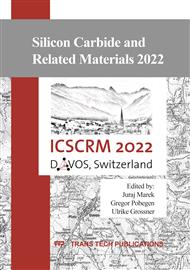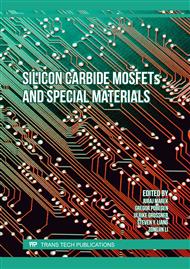[1]
S. Sridevan et al. "Lateral n-channel inversion mode 4H-SiC MOSFETs". In: IEEE Electron Device Lett. 19.7 (1998), pp.228-230.
DOI: 10.1109/55.701425
Google Scholar
[2]
Daniel J. Lichtenwalner et al. "Comparison of channel mobility and oxide properties of MOSFET devices on Si-face (0001) and A-face (11-20) 4H-SiC". In: MRS Proceedings 1693 (2014).
DOI: 10.1557/opl.2014.530
Google Scholar
[3]
G. Rescher et al. "Improved Interface Trap Density Close to the Conduction Band Edge of aFace 4H-SiC MOSFETs Revealed Using the Charge Pumping Technique". In: Silicon Carbide and Related Materials 2016. Vol. 897. Materials Science Forum. Trans Tech Publications Ltd, June 2017, pp.143-146.
DOI: 10.4028/www.scientific.net/msf.897.143
Google Scholar
[4]
Hui-feng Li et al. "Interfacial characteristics of N2O and NO nitrided SiO2 grown on SiC by rapid thermal processing". In: Appl.Phys.Lett. 70.15 (1997), pp.2028-2030.
DOI: 10.1063/1.118773
Google Scholar
[5]
V. V. Afanas'ev et al. "Mechanisms responsible for improvement of 4H-SiC/SiO2 interface properties by nitridation". In: Appl.Phys.Lett. 82.4 (2003), pp.568-570.
DOI: 10.1063/1.1532103
Google Scholar
[6]
Judith Berens et al. "NH3 and NO + NH3 Annealing of 4H-SiC Trench MOSFETs: Device Performance and Reliability". In: IEEE Trans. Electron Devices 66.11 (2019), pp.4692-4697.
DOI: 10.1109/ted.2019.2941723
Google Scholar
[7]
Eckhard Pippel et al. "Interfaces between 4H-SiC and SiO2: Microstructure, nanochemistry, and near-interface traps". In: J.Appl.Phys. 97.3 (2005), p.034302.
DOI: 10.1063/1.1836004
Google Scholar
[8]
G. Y. Chung et al. "Effect of nitric oxide annealing on the interface trap densities near the band edges in the 4H polytype of silicon carbide". In: Appl.Phys.Lett. 76.13 (2000), pp.1713-1715.[9] Christian Schleich et al. "Physical Modeling of Bias Temperature Instabilities in SiC MOSFETs". In: Proc. Intl. Electron Devices Meeting (IEDM). 2019.
DOI: 10.1063/1.126167
Google Scholar
[10]
A. J. Lelis et al. "Time Dependence of Bias-Stress-Induced SiC MOSFET Threshold-Voltage Instability Measurements". In: IEEE Trans. Electron Devices 55.8 (2008), pp.1835-1840.
DOI: 10.1109/ted.2008.926672
Google Scholar
[11]
M. Waltl et al. "Performance Analysis of 4H-SiC Pseudo-D CMOS Inverter Circuits Employing Physical Charge Trapping Models". In: Materials Science Forum 1062 (2022), pp.688-695.
DOI: 10.4028/p-pijkeu
Google Scholar
[12]
Y. Hernandez et al. "Impact of Bias Temperature Instabilities on the Performance of Logic Inverter Circuits Using Different SiC Transistor Technologies". In: Crystals 11.9 (2021).
DOI: 10.3390/cryst11091150
Google Scholar
[13]
G. Rescher et al. "On the subthreshold drain current sweep hysteresis of 4H-SiC nMOSFETs". In: Proc. Intl. Electron Devices Meeting (IEDM). 2016, p.10.8.1-10.8.4.
DOI: 10.1109/iedm.2016.7838392
Google Scholar
[14]
Christian Schleich et al. "Single vs. Multi-Step Trap Assisted Tunneling Currents - Part I: Theory". In: IEEE Trans. Electron Devices (2022). in print.
DOI: 10.1109/ted.2022.3185966
Google Scholar
[15]
Christian Schleich et al. "Single vs. Multi-Step Trap Assisted Tunneling Currents - Part II: The Role of Polarons". In: IEEE Trans. Electron Devices (2022). in print.
DOI: 10.1109/ted.2022.3185965
Google Scholar
[16]
Tibor Grasser. "Stochastic charge trapping in oxides: From random telegraph noise to bias temperature instabilities". In: Microelectronics Reliability 52.1 (2012), pp.39-70.
DOI: 10.1016/j.microrel.2011.09.002
Google Scholar
[17]
W. Goes. "Hole Trapping andthe Negative Bias Temperature Instability". Ph.D. Thesis. TU Wien, 2011.
Google Scholar
[18]
K. Puschkarsky et al. "Review on SiC MOSFETs High-Voltage Device Reliability Focusing on Threshold Voltage Instability". In: IEEE Trans. Electron Devices 66.11 (2019), pp.4604-4616.
DOI: 10.1109/ted.2019.2938262
Google Scholar
[19]
J. P. Campbell et al. "Atomic-scale defects involved in the negative-bias temperature instability". In: IEEE Trans.Dev.Mat.Rel. 7.4 (2007), pp.540-557.
Google Scholar
[20]
Gerhard Rzepa et al. "Comphy - A Compact-Physics Framework for Unified Modeling of BTI". In: Microelectronics Reliability 85.1 (2018), pp.49-65.
DOI: 10.1016/j.microrel.2018.04.002
Google Scholar
[21]
Jakob Michl et al. "Efficient Modeling of Charge Trapping at Cryogenic Temperatures-Part II: Experimental". In: IEEE Trans. Electron Devices 68.12 (2021), pp.6372-6378.
DOI: 10.1109/ted.2021.3117740
Google Scholar
[22]
Christian Schleich et al. "Physical Modeling of Charge Trapping in 4H-SiC DMOSFET Technologies". In: IEEE Trans. Electron Devices 68.8 (2021), pp.4016-4021.
DOI: 10.1109/ted.2021.3092295
Google Scholar
[23]
Alexander Vasilev et al. "TCAD Modeling of Temperature Activation of the Hysteresis Characteristics of Lateral 4H-SiC MOSFETs". In: IEEE Trans. Electron Devices 69.6 (2022), pp.3290-3295.
DOI: 10.1109/ted.2022.3166123
Google Scholar
[24]
B. Kaczer et al. "Ubiquitous relaxation in BTI stressing - New evaluation and insights". In: Proc. Intl. Rel. Phys. Symp. (IRPS). 2008, pp.20-27.
Google Scholar
[25]
H. Reisinger et al. "Analysis of NBTI Degradation- and Recovery-Behavior Based on Ultra Fast VT-Measurements". In: Proc. Intl. Rel. Phys. Symp. (IRPS). 2006, pp.448-453.
DOI: 10.1109/relphy.2006.251260
Google Scholar
[26]
M. Waltl. "Ultra-Low Noise Defect Probing Instrument for Defect Spectroscopy of MOS Transistors". In: IEEE Trans.Dev.Mat.Rel. 20.2 (2020). invited, pp.242-250.
DOI: 10.1109/tdmr.2020.2988650
Google Scholar
[27]
Daniel B. Habersat et al. "Measurement considerations for evaluating BTI effects in SiC MOSFETs". In: Microelectronics Reliability 81 (2018), pp.121-126.
DOI: 10.1016/j.microrel.2017.12.015
Google Scholar
[28]
Dominic Waldhoer et al. "Toward Automated Defect Extraction From Bias Temperature Instability Measurements". In: IEEE Trans. Electron Devices 68.8 (2021), pp.4057-4063.
DOI: 10.1109/ted.2021.3091966
Google Scholar
[29]
C. Wilhelmer et al. "Statistical Ab-Initio Analysis of Electron Trapping Oxide Defects in the Si/SiO2 Network". In: European Solid-State Device Research Conference (ESSDERC). 2021, pp.243-246.
DOI: 10.1109/essderc53440.2021.9631833
Google Scholar



